 |
JAMES BOND
|
 |
JAMES BOND
|
|
||
|
|
Being the first EON Productions James Bond film not to star Sean Connery, On Her Majesty's Secret Service (1969) made no secret of its ‘in-jokes’ and references to earlier adventures in order to remind audiences this was still part of the same series. The U.S. trailer narration pointed out that this James Bond was different, ‘but from the same stable’; the opening gun barrel featured the producer credits as part of the white dots as they had originally in Dr. No (1962). Maurice Binder's opening titles were devised using hourglass motifs and clips from the previous five films (although not showing Sean Connery), and Draco's janitor (a midget) even whistles the theme from ‘Goldfinger’. Lazenby's Bond also has props and gadgets featured in the Sean Connery films in his desk drawer (accompanied by brief soundtrack excerpts from the films in which they appear as they appear). But perhaps the most famous ‘in-joke’ in the series was initiated by George Lazenby himself. |
|||
|
|||
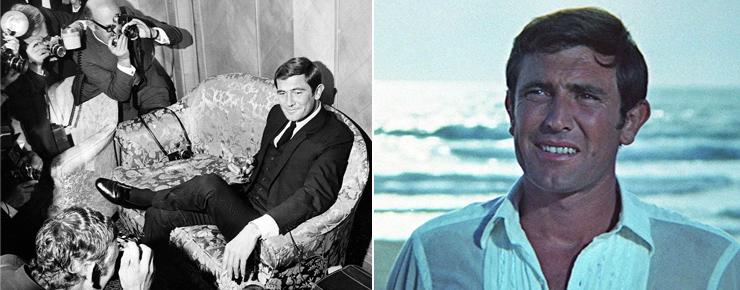 |
|||
|
From the announcement of his casting as the new James Bond in at a press conference held at London's Dorchester Hotel on October 7, 1968 (above left), and throughout the filming of On Her Majesty's Secret Service, George Lazenby was constantly vilified by the press, highlighting his lack of acting skills and simply for the fact that he wasn't Sean Connery! With director Peter Hunt insisting that Lazenby perform as many of his own stunts as possible, the actor frequently alluded to the fact that Sean Connery wouldn't have had to go through this ordeal. His throwaway line was used at the end of the pre-credit sequence (filmed towards the end of production in Portugal in May 1969) as Bond loses the girl when she drives off, leaving him holding just her shoes. Lazenby delivers the line “This never happened to the other fella” directly to camera, breaking the fourth wall by addressing the audience directly, and acknowledging the fact the filmmakers knew this was a new James Bond, and things may be a little different to what they had come to expect. |
|||
|
|||
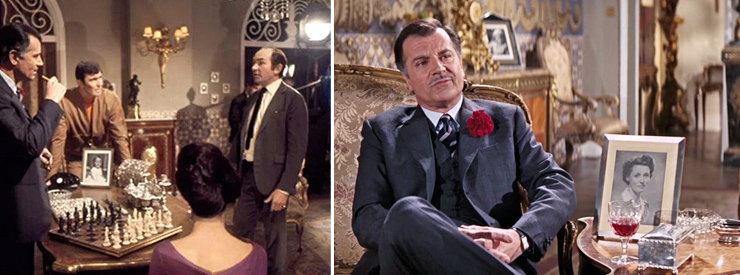 |
|||
|
Photographs of Teresa as a child and the portrait of her late mother seen in the study of Marc-Ange Draco (played by Gabrielle Ferzetti) in On Her Majesty's Secret Service (1969), are actually those of a young Diana Rigg (1938-2020) and her own mother Beryl Helliwell (1909-1981). In a change of direction from the earlier films in the series, director Peter Hunt [pictured above left with Gabrielle Ferzetti and George Lazenby] brought a sense of reality to On Her Majesty's Secret Service, that was in direct contrast to the more fantastical storyline featured in the previous film in the series, You Only Live Twice (1967). |
|||
|
|||
|
|||
|
Bessie Love (1898-1986), who has a cameo role as an American tourist at the casino table in On Her Majesty's Secret Service, had been a major star in the silent and early sound era, and nominated for an Oscar for her performance in The Broadway Melody (1929). Her career was more or less over by 1935, and she moved to England where she continued to appear in small roles in films and television. Towards the end of her life she appeared in small roles in two high-profile films - Ragtime (1981) which starred veteran actor James Cagney in his first screen appearance for 20 years; and Reds (1981) directed by and starring Warren Beatty. Bessie Love was a friend of director Peter Hunt, so it is perhaps not a surprise that she would be cast in a small cameo role in his directorial debut. Also featured at the casino table is Shakira Baksh, who would later marry Michael Caine and appeared with her husband and Sean Connery in The Man Who Would Be King (1975). Playing the Chef de Jeu [uncredited] in the casino sequence of On Her Majesty's Secret Service (1969) is Robert Reitty, who was better-known as the vocal artiste who had provided the voices for several characters in Dr. No (1962) including Timothy Moxon as Strangways. Later returning to the series to re-voice Adolfo Celi as Emilio Largo in Thunderball (1965), and Tetsuro Tamba as Tiger Tanaka You Only Live Twice (1967). Other casino guests at the table in On Her Majesty's Secret Service (1969) were played by Steve Plytas as the ‘Greek Tycoon’, Elliott Sullivan as ‘American Guest’ [both listed in the UK Exhibitors’ Campaign Book], and Martin Leyder [listed only in the US Exhibitors’ Pressbook] as Chef de Jeu Huissier. |
|||
|
|
|||
 |
|||
|
The filmmakers had a product placement deal with the Ford Motor Company to use their vehicles in Diamonds Are Forever (1971), and Ford's only demand was that Sean Connery had to be seen driving the 1971 red Mustang Mach 1. Filming the sequence where Bond flips the car onto two wheels in order to escape the Las Vegas sheriff proved very difficult to achieve on location, and was completed on the Universal Studios backlot with different stunt drivers. American stuntman Buzz Bundy (1930-2020) had performed the stunt on location with the Mustang exiting the alleyway on the correct two wheels, but the footage was unusable as crowds of onlookers were visible in the shot. Unfortunately the driving team at the studio performed the stunt on the opposite two wheels to the location footage, so a new studio insert shot of Sean Connery and Jill St. John inside the car was filmed to give the impression Bond flipped the car again whilst inside the alleyway. This glaring continuity error consequently marred an otherwise cleverly executed stunt sequence. |
|||
|
|
|||
|
|||
|
Two characters not featured in Ian Fleming's 1956 novel DIAMONDS ARE FOREVER were named after the title character of the 1942 Walt Disney classic Bambi, and his rabbit friend ‘Thumper’. Location shooting took place at the Elrod House in Palm Springs where Bond battles Bambi (Lola Larson*) [credited to Donna Garrett] and Thumper (Trina Parks) before rescuing kidnapped millionaire Willard Whyte, played by American country singer Jimmy Dean (1928-2010). The futuristic building was designed by John Lautner (1911-1994), who had been apprentice to influential American architect Frank Lloyd Wright (1867-1959). The Elrod House incorporated a large natural rock outcrop at the edge of the room, creating the impression that the fabric of the building is fused with the rock itself, and could have easily have been designed by Ken Adam. The polished aluminium and glass structure with adjoining swimming pool was very much in the style of Adam’s distinctive sets featured in four of the six previous James Bond films. *Lola Larson was in fact a stage name/pseudonym used for the Olympic gymnast Mary Hiller, who wished to remain anonymous at the time. |
|||
|
|
|||
|
|
|||
|
It took crocodile wrangler and stuntman Ross Kananga (1945-1978) [the villain in the film played by Yaphet Kotto (1939-2021) was also named after him] six takes to complete the scene in Live And Let Die (1973) where he doubles for Roger Moore and escapes from a small island by running over the backs of three crocodiles. Kananga received $60,000 for the stunt, filmed at Swamp Safari, his 350 acres of mangrove swamp on Jamaica's North coast, where he kept over 1,000 crocodiles. In a 1973 interview he explained; “...something like that is almost impossible to do. So, I had to do it six times before I got it right. I fell five times. The film company kept sending to London for more clothes. The crocs were chewing off everything when I hit the water, including shoes. I received 193 stitches on my leg and face.” It was Roger Moore's suggestion that Kananga perform the stunt wearing crocodile shoes! The crocodile referred to in the film as ‘Old Albert’ (which took off Tee Hee's [played by Julius W. Harris] right arm) was named after Live And Let Die co-producer Albert R. ‘Cubby’ Broccoli. |
|||
|
|||
|
|||
 |
|||
|
The corkscrew jump featured in The Man With The Golden Gun (1974) was conceived several years before the film went into production. Researchers at Cornell University were studying rollover collisions for the National Highway Traffic Safety Administration, and created a computer simulation of the barrel roll stunt used in The Man With The Golden Gun. Race car driver W. J. (known as Jay) Milligan, Jr., was the promoter of the American Thrill Show during the 1960s and 1970s. With the sponsorship of the American Motors Corporation he performed the stunt, known as the ‘Astro Spiral Jump’, and it debuted on January 12, 1972, at the Houston Astrodome using an AMC Javelin. Milligan was contacted by producer Albert R. Broccoli during an American Thrill Show performance in Hershey, Pennsylvania. The James Bond producers allegedly took out patents and copyrights on the stunt, as they did not wish it to appear in another film before they had used it. The 360-degree car-spiralling jump over a Thai canal was performed in just one take by stuntman Loren “Bumps” Willert (uncredited in the film and pictured above being congratulated by Roger Moore) as eight cameras simultaneously captured the spectacle. The stunt was so rapid that it is shown in slow motion in the finished film. Willert was given a large bonus for completing the jump on the first take. The spiral jump is also credited with being the first stunt ever to be calculated by computer modelling. Jay Milligan [pictured above right between Loren Willert and Roger Moore] performed the driving stunts with the AMC Hornet used in the film. |
|||
|
|||
|
After the disappointing
box-office returns for Roger Moore's second 007 adventure The Man With
The Golden Gun (1974), Albert R. Broccoli, free of his
producing partner Harry Saltzman, pulled out all the stops for James
Bond’s tenth cinematic entry. The film was make or break for the Bond
series and Broccoli had no intention of playing it safe. Instead, he made
the biggest Bond yet. The Spy Who Loved Me is a greatest hits
package celebrating everything Bond: his British-ness, the best in Bond
Girls, the coolest gadgets and cars, a steel-toothed villain, and a
globe-trotting plot involving a tanker that swallows nuclear submarines
from Russia and the United Kingdom, with the intention of triggering World
War Three. Only 007, teaming up with Soviet Agent Major Anya Amasova
(played by Barbara Bach) can save the day. |
|||
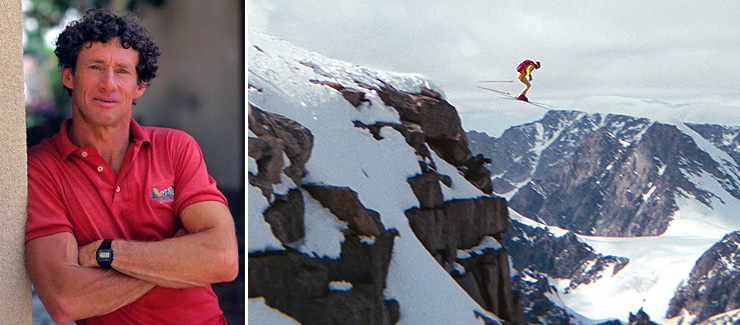 |
|||
|
Those familiar with James Bond know the character’s long history with PLAYBOY magazine; and it was a 1976 Canadian Club Whiskey advertisement spotted by in the magazine by ‘Cubby’ Broccoli's stepson Michael G. Wilson, featuring a daredevil skier leaping off Mount Asgard in the Canadian Baffin Mountains, that set the idea of the opening stunt in motion. Wilson showed the advertisement to his stepfather who loved the image, and soon after they tracked down the man who supposedly performed the stunt. Rick Sylvester had already done the jump for fun off El Capitan in Yosemite Park in 1972, but the image used for the Canadian Club Whiskey advertisement was ultimately a mocked-up publicity shot, as the American climber and stuntman had actually aborted the attempted jump off Mount Asgard at that point. John Glen, who later directed five James Bond films, headed the second unit on The Spy Who Loved Me; the unit had the tough mission of filming the stunt, and after shooting some test footage were given the go-ahead to perform the stunt for real. The second unit flew to Mount Asgard. As the top is a plateau it was perfect for the end of the ski chase where Bond takes flight off the precipice. But immediately there were problems with the weather, as the second unit’s director of photography Alan Hume recalled in his book A Life Through The Lens: Memoirs of a Film Cameraman: “...standing on that mountain going snow-blind – as everything around us was totally white – I wondered if we’d made the right decision.” |
|||
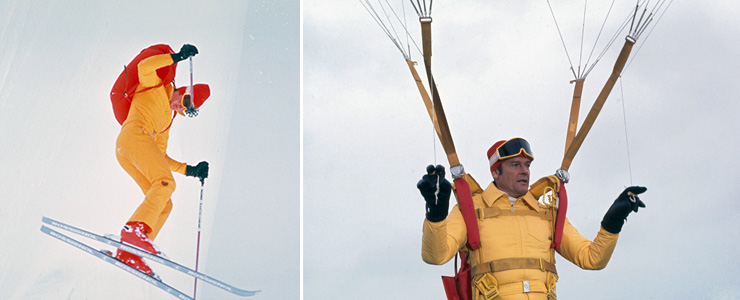 |
|||
|
With conditions worsening the crew waited for the wind to drop. With a brief window of calm weather and three cameras ready to capture the action, Sylvester skied right off the precipice into the cold void below. The helicopter cameraman failed to capture Sylvester, who had skied over the top of the camera. With the master shot gone, John Glen (who also edited The Spy Who Loved Me) hoped one of the cameras had caught the shot. Ultimately only one other camera managed to follow Sylvester all the way off the precipice, zoomed in and followed him all the way down. The sequence as seen in the finished film shows that one take. There are no in-camera tricks or clever editing, and the finished result has been rightly called ‘The greatest stunt of all time’ - although Sylvester claimed that gravity should also take huge credit! The World Premiere audience at London's ODEON Leicester Square burst into spontaneous applause - something that was repeated when The Spy Who Loved Me hit the big screen worldwide in Summer 1977. The Spy Who Loved Me reinvigorated interest in James Bond, and the ski jump has subsequently become one of the most iconic moments in the Bond film franchise. |
|||
|
|
|||
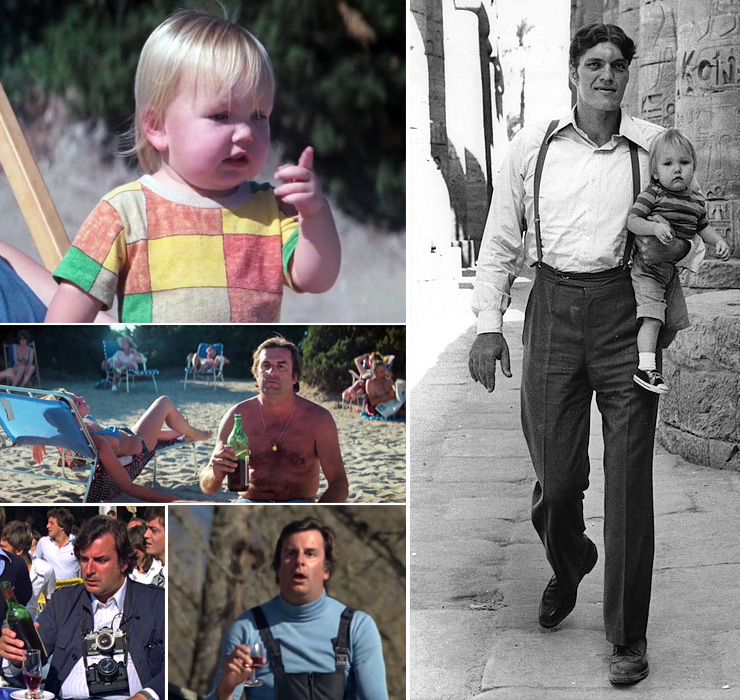 |
|||
|
The Spy Who Loved Me (1977) features a number of uncredited appearances, both on and off screen. Narrator of part of the Egyptian ‘Son et Lumiere’ sequence at the Pyramids of Giza was English actor Charles Gray (1928-2000) who had played Henderson in You Only Live Twice (1967) [also directed by Lewis Gilbert], and Ernst Stavro Blofeld in Diamonds Are Forever (1971). Charles Gray's association with the James Bond films actually goes back even further still. On November 28, 1963 Gray was selected to play Auric Goldfinger in Harold Sakata's screen test as Oddjob in Goldfinger (1964), although there is no evidence to suggest he was ever considered for the lead role of the eponymous villain himself. As James Bond's Lotus Esprit rises from the sea on a beach in Sardinia, the first person to spot the car is Richard Kiel Jr. (born 1975) - son of the seven foot two inch actor who played steel-toothed villain Jaws. Also appearing in the scene is Victor Tourjansky as the uncredited ‘man with bottle’ - a performance he would reprise in Moonraker (1979) [above bottom left] and For Your Eyes Only (1981) [above bottom centre]. Tourjansky (who died in 2015) worked primarily as an assistant or second unit director, but would also receive a credit as part of the ski team in For Your Eyes Only. Director Lewis Gilbert would frequently use actors he had previously worked with in small roles in later films. Gilbert's brother-in-law Sydney Tafler (1916-1979) whose final film appearance was as the Liparus Captain in The Spy Who Loved Me (1977), and Alfie Bass (1916-1987) who was credited as ‘consumptive Italian’ in Moonraker (1979) had both memorably appeared in Alfie (1966) starring Michael Caine as the eponymous Cockney lothario. |
|
||||||
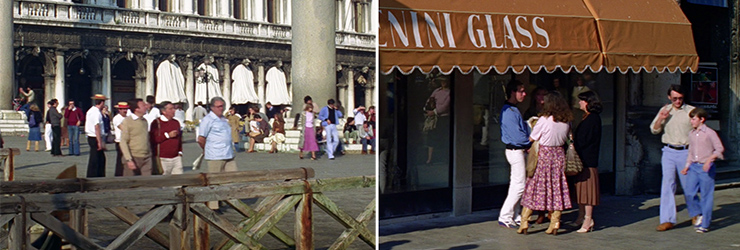 |
||||||
|
Producer Albert R. Broccoli also made a cameo appearance in Moonraker (1979) as a tourist in Venice, seen as James Bond (Roger Moore) walks into St. Mark's Square on his way to Venini Glass. ‘Cubby’ Broccoli [pictured above left in blue shirt] can be seen walking with production designer Ken Adam and associate producer William P. Cartlidge. In the next shot executive producer Michael G. Wilson walks into shot in front of Venini Glass accompanied by his son David, and also pops up as a NASA technician later in the film. Michael G. Wilson is often mistakenly identified as an audience member sat behind Barbara Bach and Nadim Sawalha during the ‘Son et Lumiere’ sequence in Egypt in The Spy Who Loved Me (1977). Closer inspection of this scene reveals this is just a similar-looking member of the audience with a beard. Similarly, he has been incorrectly singled out as one of the Russian Kremlin Council members in Octopussy (1983). Wilson was also apparently on location in Kentucky (aged 21) for location shooting on Goldfinger (1964), and it is he who allegedly doubled for Harold Sakata in the long shots of Oddjob as he exits the car at the crushing plant after disposing of the body of Mr. Solo (played by Martin Benson). Once again, closer examination of this scene actually shows it was merely an unidentified stand-in wearing a hat. Similarly, he is reported to have been one of the Korean henchmen guarding Goldfinger's atomic bomb as it enters Fort Knox (filmed at Pinewood Studios). No photographs or documentary evidence has ever surfaced of Albert R. Broccoli's stepson at either location. However, starting with Moonraker (1979) Michael G. Wilson would appear in each subsequent film in the series to date, either as an on-screen cameo, or off-screen voice-over. See all of Michael G. Wilson's cameo appearances in the James Bond films |
||||||
|
|
||||||
|
|
||||||
|
Due to the prohibitive taxation then in place in the UK, the decision was made to move production to France, which resulted in Moonraker (1979) being the first James Bond film not to be based at Pinewood Studios, although the ‘007 Stage’ was used by the special effects crew to shoot all model work and the climactic space battle. EON Productions signed an agreement with Les Productions Artistes Associes to co-produce the film in Paris, and Ken Adam's spectacular sets utilised every available inch of studio space at Boulogne, Billancourt and Epinay. The set of M's office was kept in storage at Pinewood Studios for re-use in each film of the series, and parts were shipped across the English Channel for the scenes involving Bernard Lee (whose final film this would be), Lois Maxwell and Desmond Llewelyn. |
||||||
|
|
||||||
 |
||||||
|
The James Bond films frequently used audio ‘in-jokes’ on the soundtrack to highlight action on the screen, and sometimes as diegetic sounds that occur within the context of the story, and therefore able to be heard by the characters. Both types can be heard in Moonraker (1979). As Roger Moore's Bond watches one of Drax’s technicians enter the door code to a Venetian laboratory, the tune heard as the buttons are pressed are composer John Williams’ 5-note theme used to communicate with the extra-terrestrials in Steven Spielberg's Close Encounters Of The Third Kind (1977). The use of the theme was reciprocated in the Spielberg produced 1985 comedy-adventure The Goonies (directed by Richard Donner) when EON Productions allowed Amblin Entertainment to feature Monty Norman's ‘The James Bond Theme’ on the soundtrack when the character of Richard “Data” Wang, a James Bond fanatic and amateur gadgeteer Goonie (played by Ke Huy Quan), makes a Bond-like entrance in the film. Earlier audio ‘in-jokes’ can be heard in On Her Majesty's Secret Service (1969) as Draco's janitor whistles the ‘Goldfinger’ theme as James Bond (played by George Lazenby) enters the offices of Tracy's father played by Gabriele Ferzetti (played by Gabrielle Ferzetti). Composer Marvin Hamlisch humorously chose to integrate the ‘Theme from Lawrence of Arabia’ (1962), composed by Maurice Jarre, into his score for The Spy Who Loved Me (1977) as Bond and Anya walk across the desert after their truck breaks down. This music is an ‘in-joke’ just for the audience, but earlier in the film we also hear Maurice Jarre's ‘Lara's theme’ from Doctor Zhivago (1965) when Anya Amasova (played by Barbara Bach) opens a music box transmitter in the pre-credit sequence. Composer John Barry also highlights the action on screen with his re-orchestration of Elmer Bernstein's ‘The Magnificent Seven Theme’ in Moonraker (1979), as Roger Moore (wearing a Clint Eastwood style poncho) rides across the Brazilian pampas on his way to meet M (played by Bernard Lee). Like John Barry's later use of the Gidea Park 1980 cover version of the Beach Boys ‘California Girls’ in the pre-credit sequence of A View To A Kill (1985), this music was interpolated into the background score, so not a diegetic sound that would be heard as part of the narrative. In For Your Eyes Only (1981) when Bond enters the identigraph photo-fit room, the sounds heard as Q (played by Desmond Llewelyn) presses the door code are actually the first five notes of ‘Nobody Does It Better’ from The Spy Who Loved Me (1977) - Bond then enters the final two notes of the sequence so the door will open! In Licence To Kill (1989) when you listen very carefully to the sounds in the scene where James Bond (played by Timothy Dalton) is dangling beneath the tanker (at approx 117 minutes into the film) whilst being shot at by the villain Sanchez (played by Robert Davi), you can hear bullets ricochet to create ‘The James Bond Theme’! |
||||||
|
|
||||||
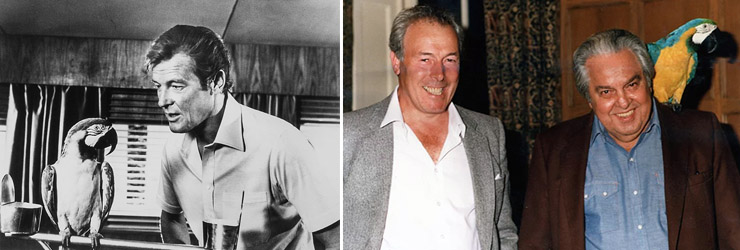 |
||||||
|
‘Max’, the Havelocks’ parrot in For Your Eyes Only (1981) [pictured above left with Roger Moore], belonged in real life to stunt woman Cyd Child, who doubled for Cassandra Harris and Carole Bouquet in a number of shots in the film. In her autobiography, Child explained that the bird (a blue and gold macaw named ‘Chrome’) had originally belonged to Diana Rigg (1938-2020), with whom she become friends when doubling for the actress in episodes of the popular TV-series The Avengers. Director John Glen [pictured above right with producer Albert R. Broccoli] later featured Chrome in The Living Daylights (1987) in scenes at the Blayden Safe House and kitchen fight sequence between Andreas Wisniewski and stuntman Bill Weston. |
||||||
|
||||||
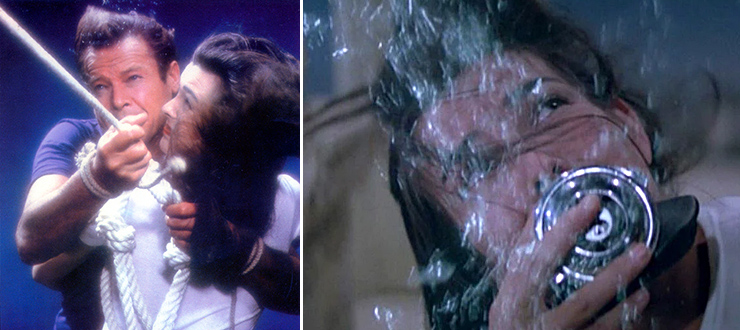 |
||||||
|
Due to a pre-existing sinus condition French actress Carole Bouquet could not perform any of the several underwater sequences featuring her character Melina Havelock. Although Bouquet did film some of the above water action in Corfu, the filmmakers came up with an ingenious solution to the problem by filming all of the underwater shots at Pinewood Studios, in a ‘dry for wet’ scenario. Close shots of the principal actors were filmed in the studio on a dry set. To get a realistic effect of hair movement, general slowness and weightlessness, which is so apparent in real underwater filming, special effects supervisor Derek Meddings shot some tests, running the camera at 120 fps and using strong wind machines to blow the hair upwards and from side to side. Also used were foreground glass fish tanks for bubble effects. Later, more bubbles were superimposed into critical areas of the picture. These tests were very effective and proved for the most part to be undetectable from the real thing. Even 40 years later much of the ‘underwater’ sequences still stand up well, fooling modern audiences with the tried and tested ‘smoke and mirrors’ approach to filmmaking. |
||||||
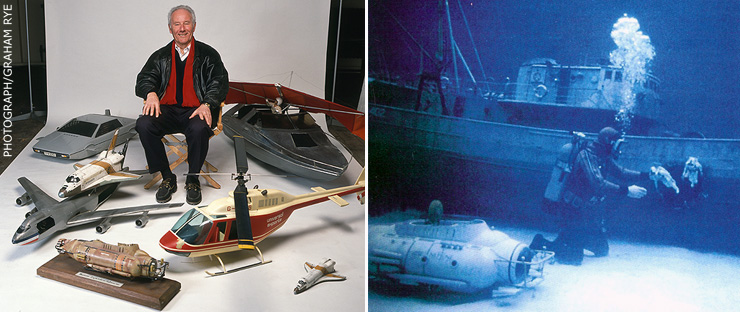 |
||||||
|
Derek Meddings also provided the clever miniature work featured in the film, with everything from scale models of helicopters and forced perspective buildings, to model ships and explosions. In the era before computer generated images, this ‘Heath Robinson’ way of making things work proved remarkably effective. |
||||||
|
|
||||||
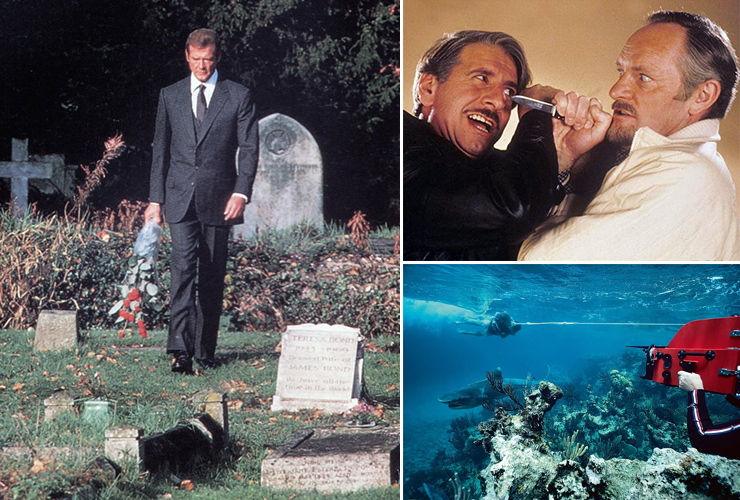 |
||||||
|
Roger Moore's fifth James Bond film For Your Eyes Only (1981), marked a return to a more traditional style of filmmaking, after the excesses of The Spy Who Loved Me (1977) and Moonraker (1979). The film opens with James Bond visiting the grave of his murdered wife Tracy, which bears the inscription ‘We Have All The Time In The World’ - the final line of On Her Majesty's Secret Service (1969) spoken by George Lazenby's Bond, and a reminder that although the actor was different, this was still the same character. A brief mention of Bond's wife had also featured in The Spy Who Loved Me (1977). Screenwriter Richard Maibaum had the luxury of basing most of his screenplays on original Ian Fleming novels, but more recent films had featured new storylines which differed greatly from the book they were based on. This was rectified to a large degree in For Your Eyes Only (1981), which was co-written by Maibaum, and first-time screenwriter Michael G. Wilson. They based much of the plot on two of Ian Fleming's short stories from the 1960 FOR YOUR EYES ONLY anthology. The Judy Havelock (changed to Melina for the film) revenge storyline was taken from FOR YOUR EYES ONLY; the characters of Columbo and Kristatos and their drug smuggling back story is taken from RISICO, whilst the unused keel-hauling sequence from LIVE AND LET DIE was repurposed in For Your Eyes Only (1981.) |
||||||
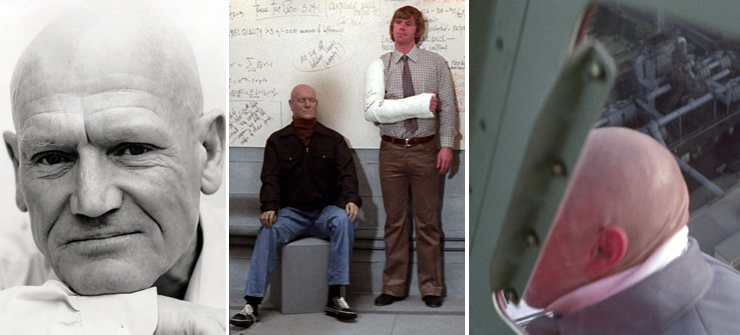 |
||||||
|
For Your Eyes Only (1981) also saw the return of Ernst Stavro Blofeld (although not named in the film for fear of legal reprisals) as the bald-headed white cat stroking villain in the pre-credit sequence. Played in the film by John Holliss (1927-2005) [pictured above left] but voiced by Robert Rietty, the distinctive bald-headed British actor had earlier appeared as Temple Priest Fred [uncredited] in the spoof version of Casino Royale (1967), and is perhaps best-remembered as Lobot in The Empire Strikes Back (1980). John Holliss had a life-cast made of his head that was used to create the none-too-convincing mask worn by the stuntman [pictured above right] who doubled for the actor as Blofeld's wheelchair is dropped down a chimney stack after being impaled on the landing skid of Bond's helicopter. The life-mask can also be seen in For Your Eyes Only (1981) as it is smashed by Smithers (Jeremy Bulloch) [pictured above centre] as James Bond (Roger Moore) enters the Q Branch workshop. |
||||||
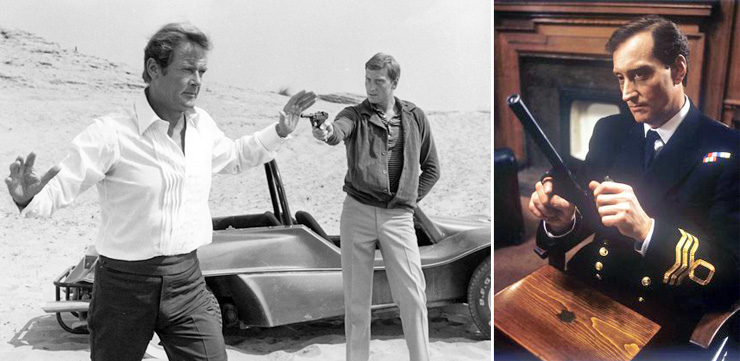 |
||||||
|
Claus, one of Kristatos’ non-speaking minor henchmen in For Your Eyes Only (1981) was played by Charles Dance in his big screen debut. After a decade of small-screen roles, Dance returned to the medium in 1989 to play Ian Fleming in Goldeneye - a TV movie produced by Anglia Films. The film focussed on Ian Fleming's wartime exploits and romantic adventures that ultimately led to his creation of James Bond. Remarkably the TV movie also features a young Christoph Waltz in a small role as a German spy! A small amount of original Ian Fleming material did make it into Octopussy (1983), but it would be the two Timothy Dalton James Bond films made at the end of the decade that would feature more of the author's storylines and characters. However, it would not be until 2006 and the debut of Daniel Craig in Casino Royale, when EON Productions would again release a film that bore an Ian Fleming title, and was actually based for much of the time on the original novel. |
||||||
 |
||||||
|
|
FACT FILES - UK Posters |
|
||||